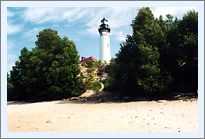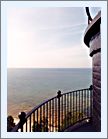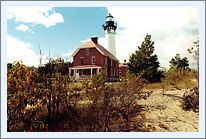 |
 |
 |
|
Click on thumbnails to view enlarged versions |
||
| Au Sable Point Light | Seeing The Light |
|
|
|
|
Historical Information
While a Light at Whitefish Point had marked the eastern end of this stretch since 1849 and the western limit had been marked by the North Light on Grand Island since 1856, the 1860's found mariners forced to blindly navigate the intervening 80 miles through some of the most treacherous waters in all of the Great Lakes. Bowing to increasing pressure from the maritime community, the Lighthouse Board finally took up the mariners call in its 1867 annual report, requesting a Congressional appropriation of $40,000 for the construction of a new coast light at a point between the Grand Island and Whitefish Point Lights. With no positive response from Congress, the Board reiterated the need in each of its annual reports for the following four years.
Prior to this Poe's influence, Eleventh District Lighthouse designs had been largely utilitarian, of basic "shoe box" design with little ornamentation or thought as to the quality of life for the station's keepers. Poe's design for the two new lights was unique, in that they were designed not only to be thoroughly appropriate for the need, but also included design elements normally reserved for major public buildings and stately homes. Poe's plans called for a cut stone foundation sixteen feet six inches in diameter supporting an 80-foot double-walled brick tower, gracefully tapering to twelve feet in diameter below the gallery, which was supported by a series of 16 ornate cast iron corbels. Immediately below the gallery, a watch room was incorporated into the tower, and featured four arch-topped windows surmounted by matching curved stone pediments. The three-story brick dwelling was to be built over a full basement, and featured a gable roof with partial hips at each end. To provide the keepers with shelter during their numerous nightly trips to the tower to tend the light, the dwelling was connected to the tower by way of an enclosed passage. A spiral cast iron stairway wound its way up the cylindrical inner core of the tower to end in a paneled circular service room at the gallery level, atop which was the prefabricated cast iron decagonal lantern was installed. A narrower gallery encircled the lantern itself provided a platform from which keepers could clean the storm panels, aided by grab handles located midway up the vertical astragals. As witness to the strategic importance placed upon this station, plans called for the lantern to be outfitted with a fixed white Third Order Fresnel lens. By virtue of tower's location atop the sand cliff, the light boasted a focal plane of 108 feet, and would be visible for a distance of 18 miles at sea.
While the Big Sable Light was a major coast light, duty at the station was as isolated as if the station had been built on an island. Other than supply visits made by the lighthouse tender, the station's only link to civilization was a winding, narrow foot path which made its way across the top of the dunes to Grand Marais. In may places the path was impassable during stormy weather when waves crashed smashed over the dunes. Life in such isolated conditions required a keeper to have special characteristics, and it was evident that Kuhn and Happold were both ill-suited for the task as they both resigned from lighthouse service on July 8, 1876.
Perhaps believing that a father and son team might fare better with Big Sable's isolation. Eleventh District Inspector Commander Joseph N. Miller appointed Frederick W Boesler and his son Frederick Jr. to the positions of Acting Keeper and Acting Assistant to replace the Beedons. For reasons that we have yet to determine, the First Assistant position was abolished on October 1, 1882, and the older Frederick continued on at the station alone until April 1884. After ten years of operation, Eleventh District Inspector Commander Horace Elmer noted that the entire station was showing signs of age and use, and a work crew was dispatched to the station in the summer of 1890 to spruce things up, and to ensure everything was in perfect operating condition. That same year, it was estimated that vessels out of Marquette carried a total of 1,772, 400 tons of ore past the station on their down-bound trip to the Soo locks. Noting that since this traffic was forced to hug the southern shore during northerly gales, the Eleventh District officers determined that the establishment of a fog signal station at Big Sable would be of great value to mariners during thick and foggy weather. To fund the project, the Lighthouse Board requested an appropriation of $5,500 in its 1892 annual report, and while Congress agreed with the need, and passed an Act approving the establishment of the signal on February 15, 1893, it neglected to make the necessary appropriation.
Remaining convinced of the need for the fog signal, the Board continued to push for the appropriation, and funding was finally approved by Congress as part of the Sundry Civil Appropriations Act of June 11, 1896. Plans and specifications for the new plant were drawn up that summer, and contracts awarded for furnishing the needed boilers, fog signal machinery and tramway. The materials, with the exception of the tramway, were delivered at the Detroit depot in September, and being so late in the season, it was decided to postpone construction until the opening of the 1897 navigation season. The following spring, the materials and a working party were loaded onboard the lighthouse tender AMARANTH and delivered at Big Sable Point. The brick fog signal building was built to the standard design used throughout the district, and was outfitted with twin 10" locomotive steam whistles fired by horizontal boilers. To supply water to the boilers, a water pickup tube was placed in a timber crib sunk offshore, and the water raised to the station by way of a force pump. While on site, the work crew also erected a sea wall in front of the new signal building to prevent erosion, extended and raised the boat dock, and replaced the wooden sidewalks with more substantial poured concrete walks. The work moved to completion at the end of August, and the new fog signal was tested and placed in operation on September 1, 1897.
After three years of wave pounding, the water supply crib had become severely damaged and a crew arrived in 1901 to replace the structure. While on site, they also rebuilt the tramway and the dwelling roof. 1904 saw the replacement of the iron smokestack in the fog signal building with a more substantial 40 foot tall brick chimney. Also in 1904, the decision was finally made to add a Second Assistant at the station, and Garfield Sweet arrived on April 11 and moved into the dwelling with Keeper Otto Bufe First Assistant Orrin Young and their families. One can only imagine the tight living accommodations the old 1874 dwelling must have provided for this group of people, since the dwelling represented cramped quarters for two keepers and their families, let alone three
Eleventh District Inspector Commander James T. Smith finally acknowledged the cramped living conditions at Big Sable, and plans were drawn up for the construction of a second dwelling for the Head Keeper, and for conversion of the original dwelling into an improved duplex layout. Work on both structures began early in 1909, and by July the work on the duplex was complete, with the building now sporting an addition at the east gable end and a full width porch with two separate entrances. The foundation for the new building had been excavated, concrete footings laid, and the buildings walls erected to the level of the first floor joists. Construction of the new dwelling continued to completion in late 1909, when keeper James Kay moved his family and belongings down the concrete walk into the spacious accommodations afforded by their new home.
As part of a general upgrading throughout the nation, the lamp at Au Sable was changed from oil wick to an incandescent oil vapor system on August 29, 1913 with an increase in output from 1,200 to 28,000 candlepower, and a corresponding increase in the visible range to 19 miles. In 1928, the steam whistles were removed from the fog signal building and replaced with a pair of Type F diaphones, which was sequenced to emitted a repeated characteristic pattern of a two blasts of 1.5 seconds duration followed by 25.5 seconds of silence. A rough road connecting the station to Grand Marais was finally constructed in 1928, providing access to the station by wagons, and opening the station to civilization for the first time. This road was significantly improved in 1943. With access to the station now open to automobiles, a double garage was erected to the south of the head keeper's dwelling in which the keepers could keep their automobiles.
With the creation of the Pictured Rocks National Lakeshore in 1966, the station reservation became a virtual island surrounded by park property. On January 12, 1968 the station reservation and buildings were incorporated into the park to open the area up to the public. While the NPS took ownership of the buildings, the Coast Guard continued to maintain ownership of the tower in order to be able to service the 300 mm solar optic which had been installed on the gallery handrail. As a result of ten years of abandonment, the structures were found to have deteriorated considerably as a result of vandalism and non- maintained exposure to the elements. While NPS planned to completely restore the station at some time in the future, time and resource restrictions limited initial work to stabilization and securing the building against further vandalism. Arrangements were made to return the Third Order lens from Cleveland, and with the lantern not yet restored, the lens as temporarily displayed at the Grand Marais Maritime Museum, which is located in that station's restored keeper's dwelling. Finally in June, 1996, the lens was returned to Au Sable, and reassembled in the lantern where it still be seen to this day.
Work is now underway in the 1909 head
keeper's dwelling, which was found to be in much better condition than
the 1876 dwelling. The first floor will be restored to function as a
visitors center, and the second floor will be converted into an
apartment for volunteers who will staff the visitor's center during the
summer season. |